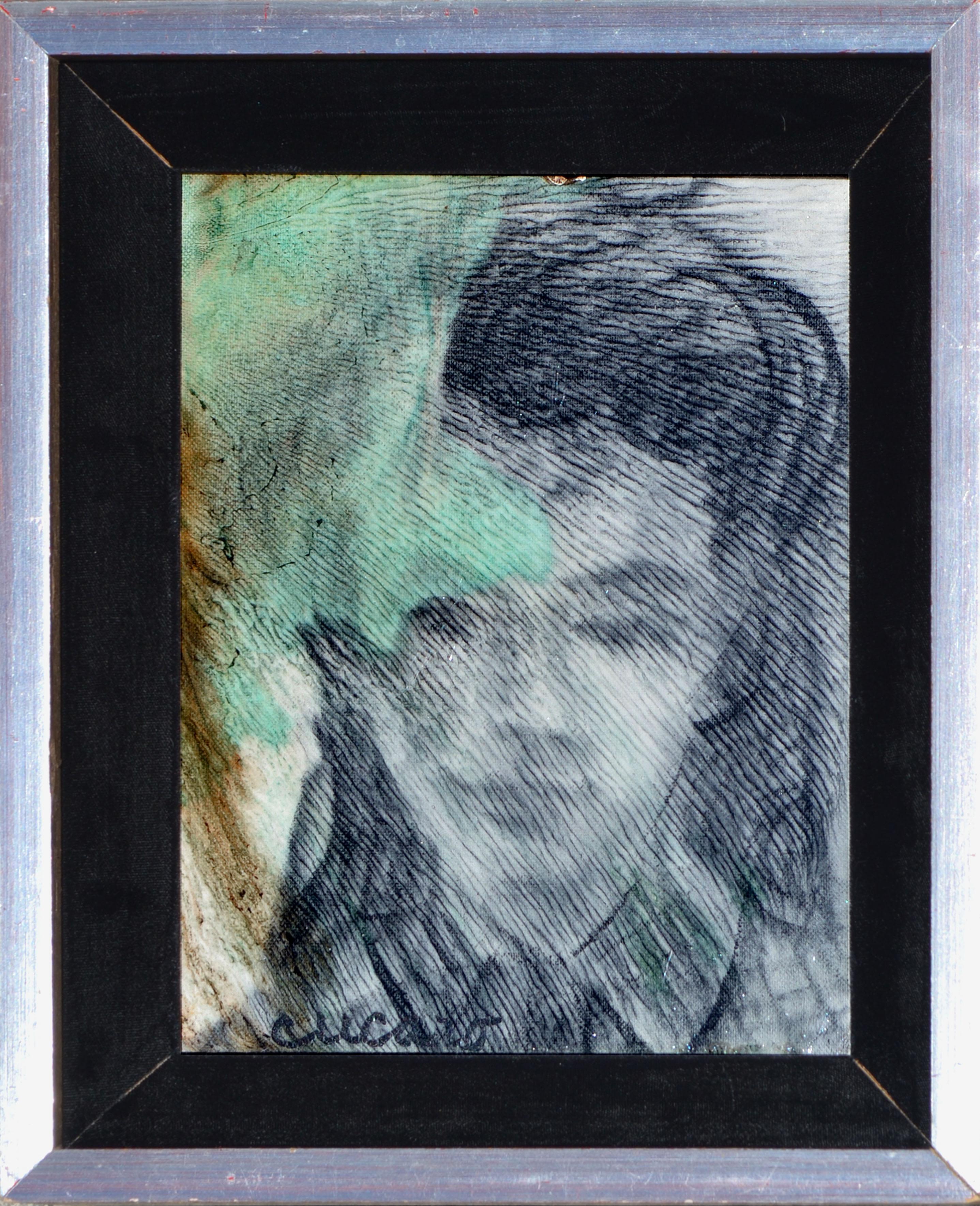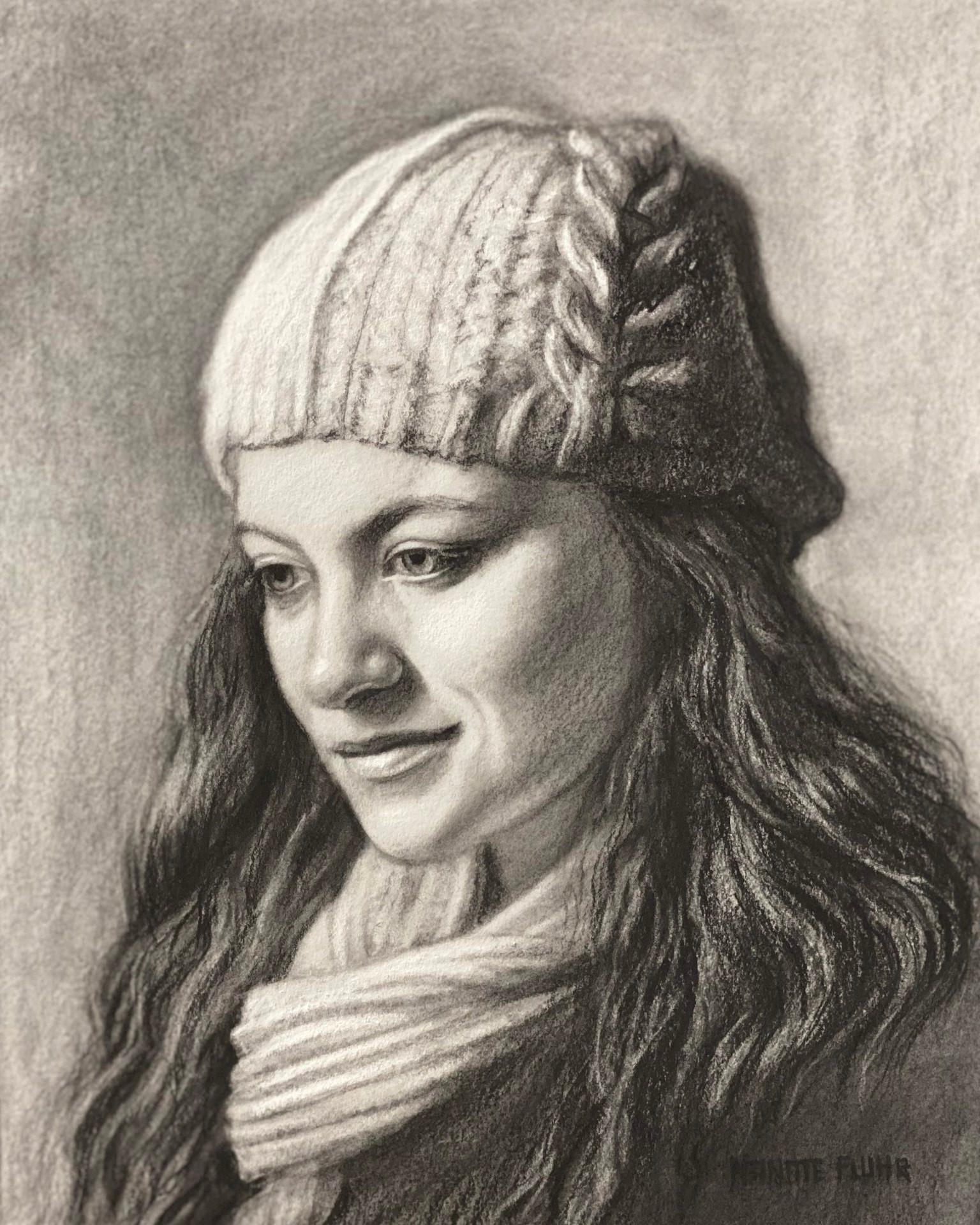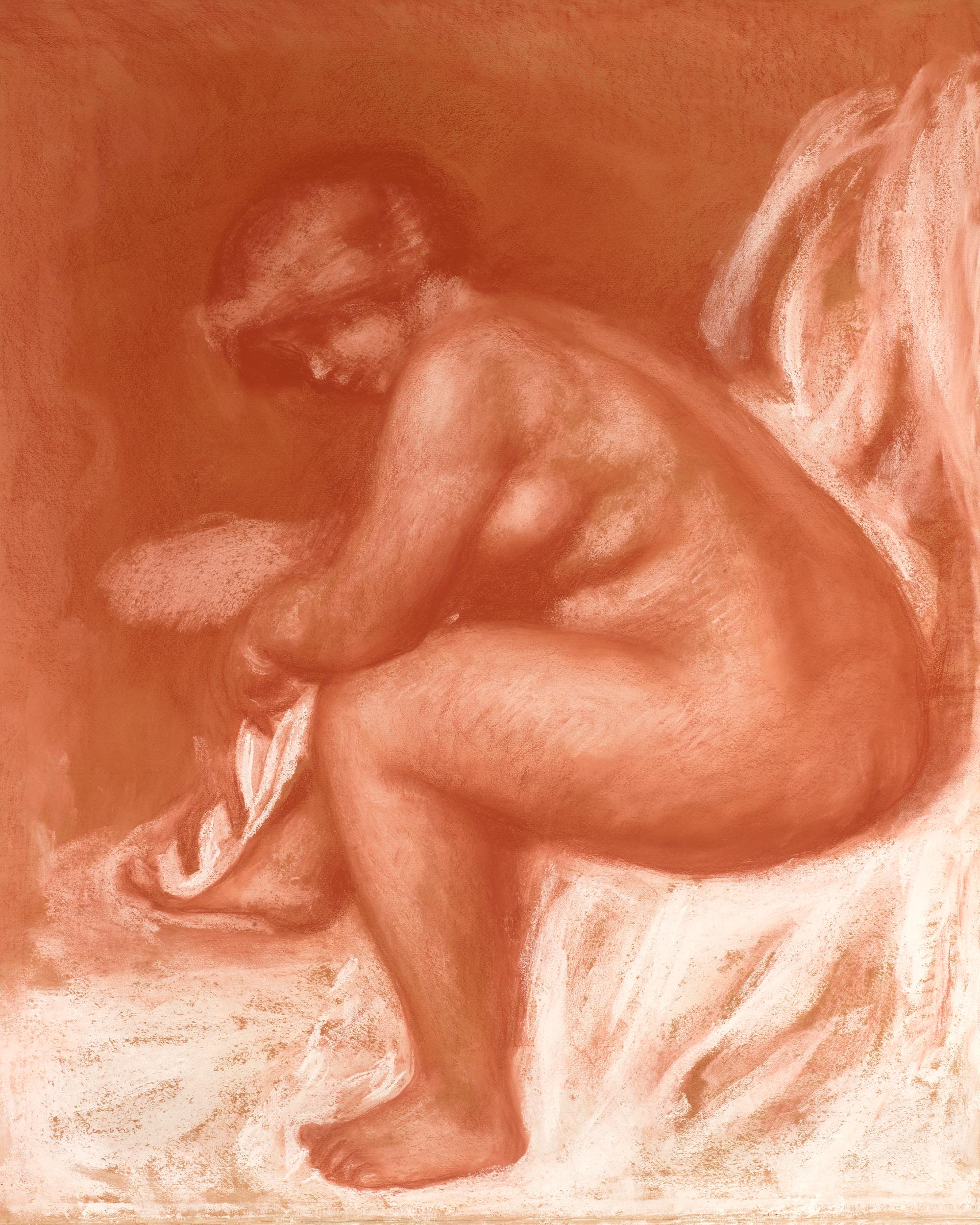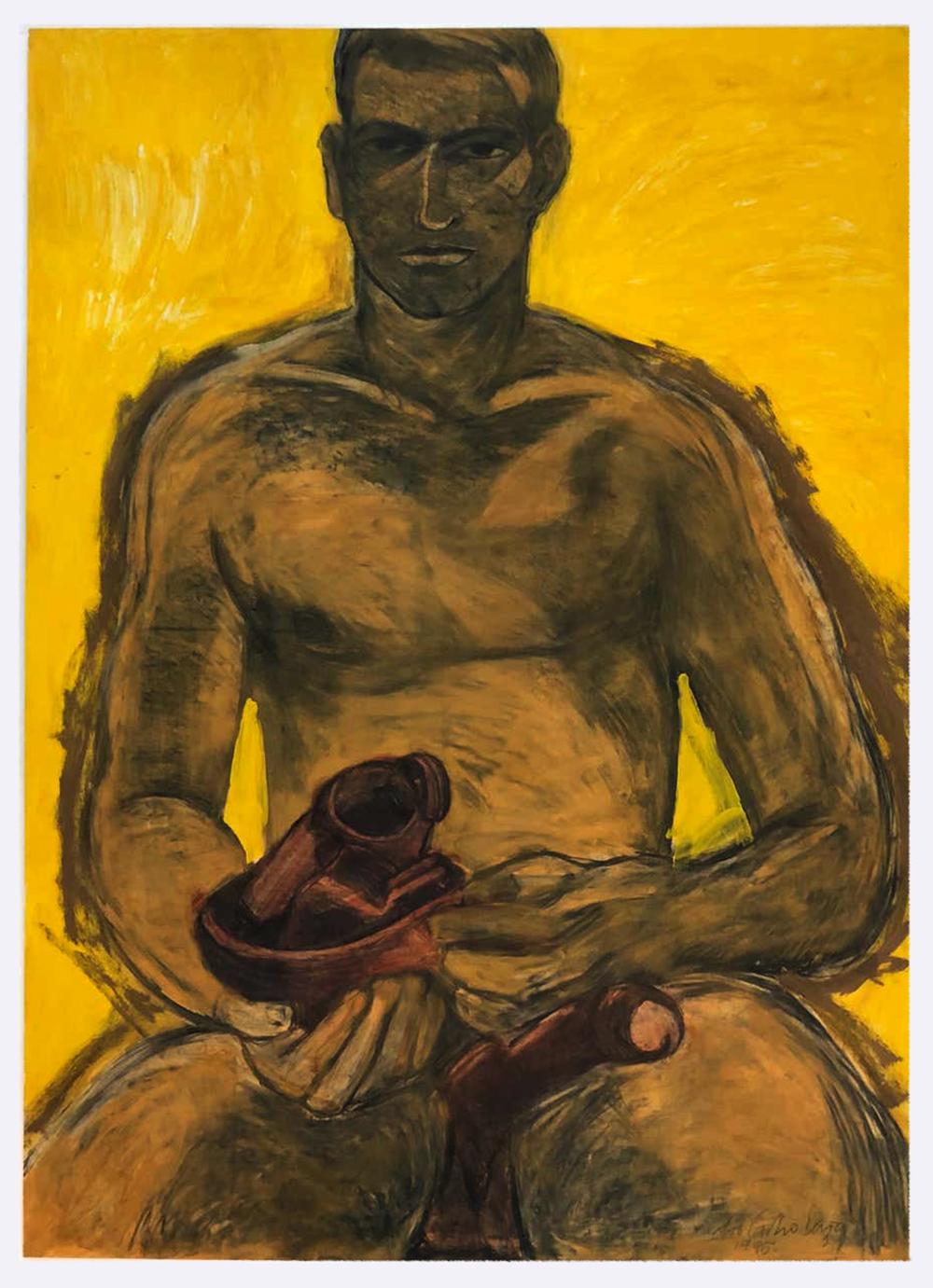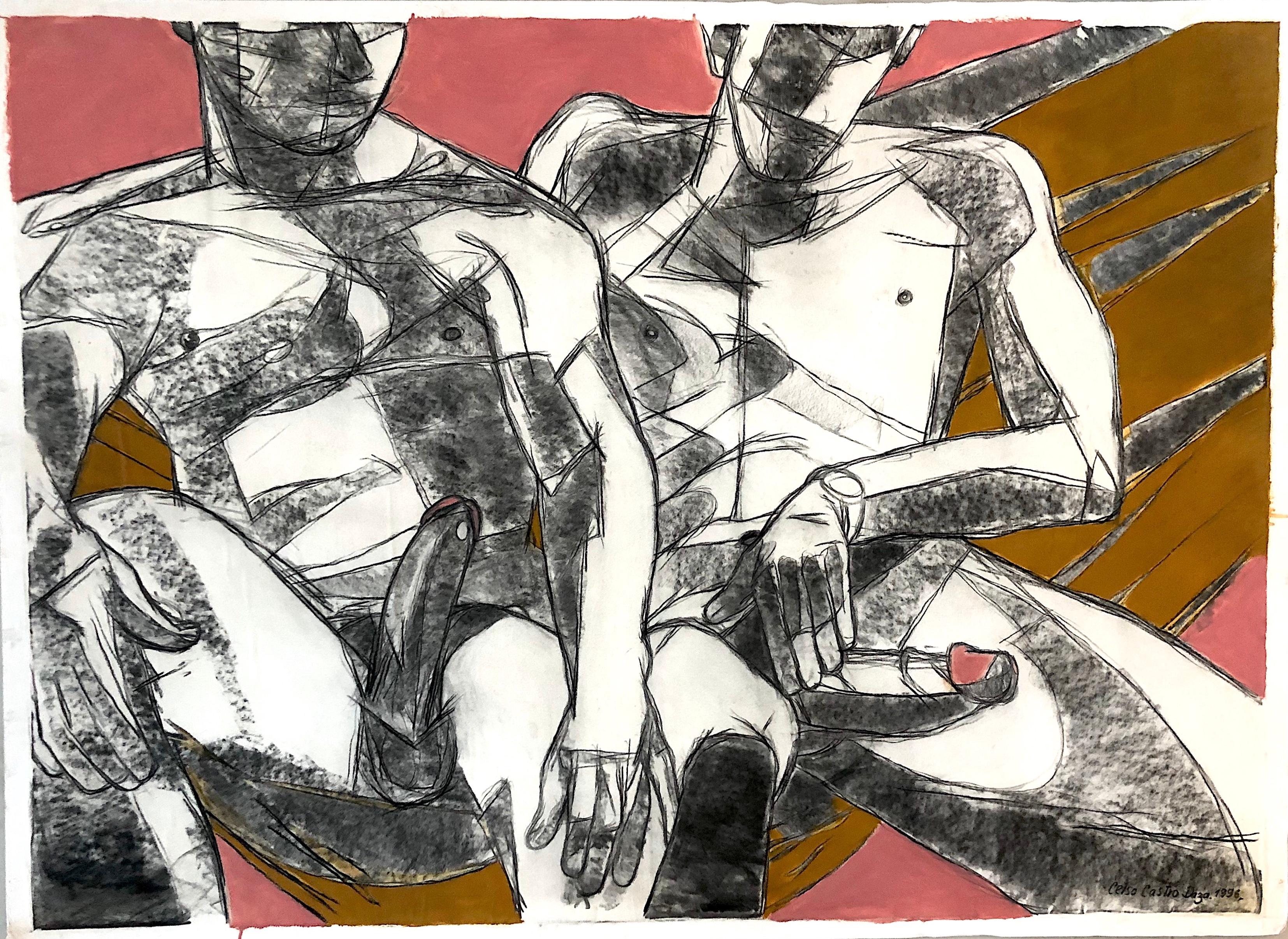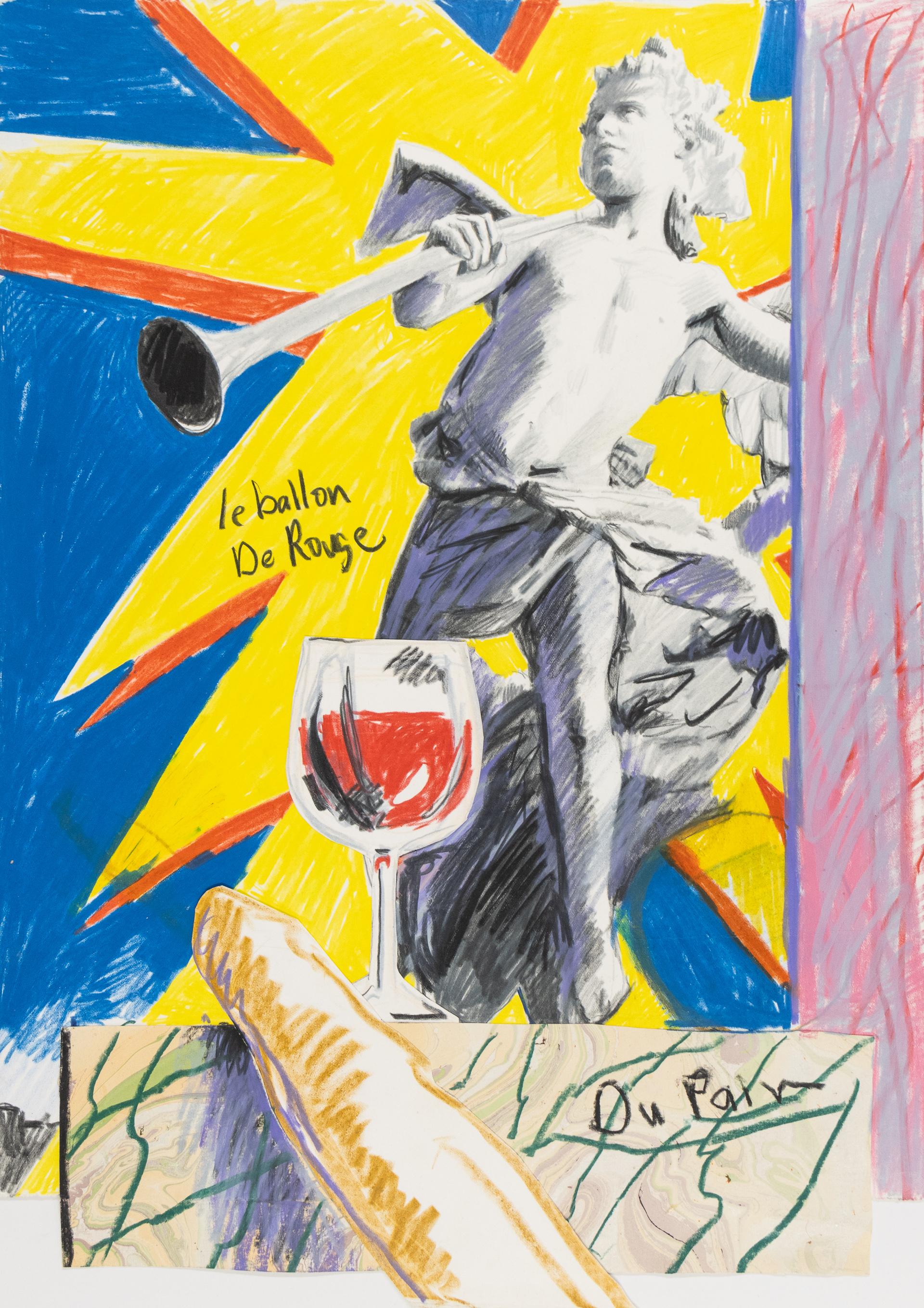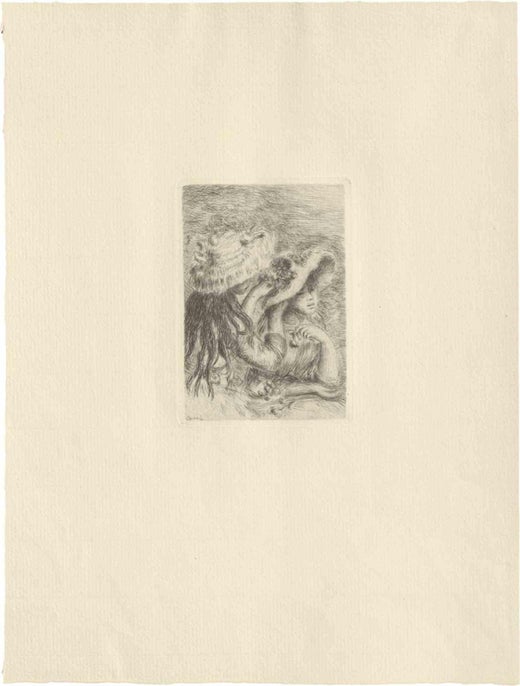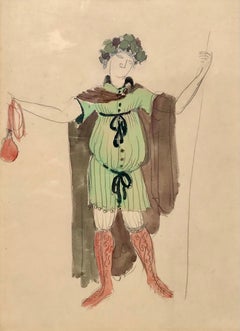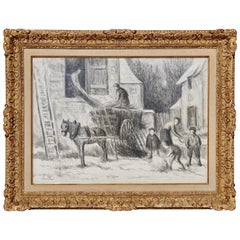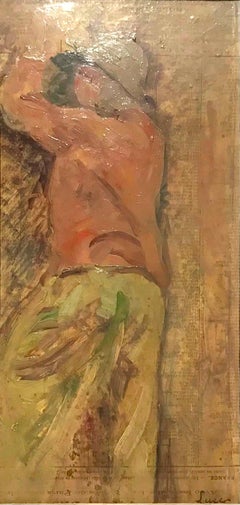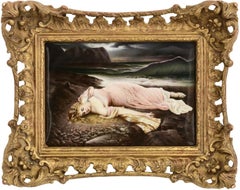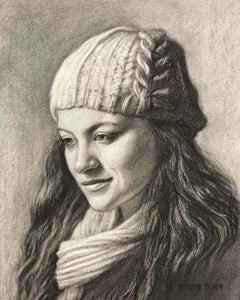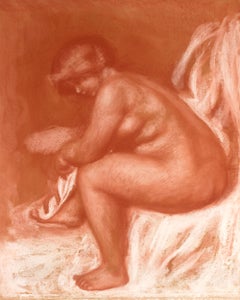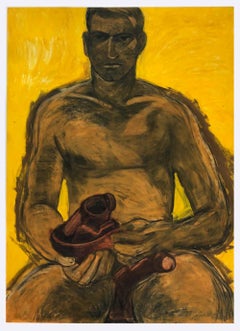Items Similar to Pierre Auguste Renoir Apres Le Bain
Want more images or videos?
Request additional images or videos from the seller
1 of 24
Pierre Auguste RenoirPierre Auguste Renoir Apres Le Bain1910
1910
$235,000
£177,630.88
€204,129.48
CA$327,236.04
A$364,036.70
CHF 190,832.60
MX$4,448,439.61
NOK 2,430,015.08
SEK 2,287,523.02
DKK 1,523,748.93
Shipping
Retrieving quote...The 1stDibs Promise:
Authenticity Guarantee,
Money-Back Guarantee,
24-Hour Cancellation
About the Item
Pierre-Auguste Renoir’s Apres Le Bain is a stunning 22 x 26-inch pencil and red chalk painting depicting a nude woman after her bath. This large, exquisitely detailed work showcases Renoir’s mastery of form and delicate use of forthought. Extremely rare and significant, it holds immense importance in the art market, embodying the Impressionist’s sensual and intimate style.
Pierre Auguste Renoir (French, 1841-1919)
Après le Bain, circa 1910
pencil and red chalk on tracing paper
Sheet: 26.5 x 21.75 Inches. (67.3 x 55.2cm)
Frame: 39 X 33.5 x 3 Inches
From the Collection of Sidney Rothberg, Philadelphia, Pennsylvania with an impeccable provenance.
Literature
The present work will be included in the forthcoming catalogue critique of Pierre-Auguste Renoir being prepared by the Wildenstein Institute established from the archives of François Daulte, Durand-Ruel, Venturi, Vollard and Wildenstein. It will be accompanied by a Letter of Inclusion from the Wildenstein Plattner Institute, Inc.
Provenance
The Artist.
To his son, Pierre Renoir.
To Madame Pierre Renoir, Paris (widow of the artist's son).
Sotheby's, London, sale of December 2, 1987, lot 447.
Acquired directly from the above sale.
Jeffrey Fuller Fine Art, Philadelphia.
Acquired directly from the above sale.
Mr. Rothberg had a distinct appreciation for studies that prepared for later, finished works. These drawings aligned with his particular collecting philosophy, which centered on uncovering an artist's creative process. He believed that drawings most clearly revealed the inner workings of an artist’s mind.
The current drawing fits seamlessly within this collecting vision. Created around 1910, it serves as a preparatory study for a painting of the same title (now held in a private collection) and exemplifies Renoir’s refined, modern style of the early 20th century. Executed in red chalk—a deliberate reference to an 18th-century technique—the piece features fluid curves and confident lines, evoking the influence of Rubens and Tintoretto, two masters whom Renoir deeply admired.
Condition Report
In overall Very Good condition. The tracing paper is toned, and entirely laid down to the support board via white paper tape along all four edges (underneath which we notice remnants of old brown tape). Lightly faded, with remnants of red chalk around the figure up top (likely due to some rubbing). Discolored outer edges (mostly covered when the work is framed). With minor folds along the outer edges, lightly brittled, due to the mounting. Restorations to edges, tears and notable on lower left and upper left corners (1/2 and 1.5 square inches) fine undulations on some edges visible on photos out of frame. Presents beautifully. Frame in good condition and fitting of work but can be changed to buyers tatste.
Pierre-Auguste Renoir (born February 25, 1841, Limoges, France—died December 3, 1919, Cagnes) was a French painter originally associated with the Impressionist movement. His early works were typically Impressionist snapshots of real life, full of sparkling color and light. By the mid-1880s, however, he had broken with the movement to apply a more disciplined, formal technique to portraits and figure paintings, particularly of women.
Renoir was born into a family of artisans. His father, a tailor who had seven children, moved with his family to Paris about 1845. Renoir demonstrated his gift at an early age. Quickly recognizing his talent, his parents apprenticed him, at age 13, to work in a porcelain factory, where he learned to decorate plates with bouquets of flowers. Shortly after that, he was painting fans and then cloth panels representing religious themes for missionaries to hang in their churches. His skill and the great pleasure he took in his work soon convinced him he should study painting in earnest. Having saved a little money, he decided, in 1862, to take evening courses in drawing and anatomy at the École des Beaux-Arts as well as painting lessons at the studio of Charles Gleyre, a Swiss painter who had been a student of the 19th-century Neoclassical painter Jean-Auguste-Dominque Ingres. Although the academic style of his teacher did not suit Renoir, he nevertheless accepted its discipline in order to acquire the elementary skills needed to become a painter.
AVANTIQUES is dedicated to providing an exclusive curated collection of Fine Arts, Paintings, Bronzes, Asian treasures, Art Glass and Antiques. Our inventory represents time-tested investment quality items with everlasting decorative beauty. We look forward to your business and appreciate any reasonable offers. All of our curated items are vetted and guaranteed authentic and as described. Avantiques only deals in original antiques and never reproductions. We stand behind our treasures with a full money back return policy if the items are not as described.
- Creator:Pierre Auguste Renoir (1841 - 1919, French)
- Creation Year:1910
- Dimensions:Height: 39 in (99.06 cm)Width: 33.5 in (85.09 cm)Depth: 2.5 in (6.35 cm)
- Medium:
- Movement & Style:
- Period:
- Condition:
- Gallery Location:Dallas, TX
- Reference Number:1stDibs: LU2724216692002
Pierre Auguste Renoir
Pierre-Auguste Renoir had his first experience with art in 1845 at the age of 4 when his family moved to Paris from Limoges and settled near the Louvre. By the age of 13, he had begun to seriously study and practice his work. Renoir started as an apprentice painter in a porcelain factory, where he spent five years. He then took drawing lessons from Charles Gleyre and in 1862, when he was 21; Renoir attended the Ecole des Beaux-Arts. It was at the National School of Fine Arts in Paris where Renoir met the future founders of Impressionism, Claude Monet, Alfred Sisley, and Frederic Bazille. Renoir paintings remained in the traditional style during the 1860s. His portrait of his mistress, Lise Trehot, was traditional enough to be accepted for the 1867 Salon. Pierre Auguste Renoir’s paintings began to change shortly after he moved in with Claude Monet and Frederic Bazille in 1869. Renoir updated his technique and color scheme. Renoir painted mostly outdoors and began to use vibrant, pure colors and little brush strokes. Renoir, along with Claude Monet, Camille Pissarro, and Alfred Sisley was part of the first exhibition of the Society of Independent Artists in 1874. It was at this exhibit that the term “Impressionism” was first used. The term was coined by a French art critic who took the name from a Monet painting. The term was meant to be derogatory and the show was a financial failure. Despite the failure, the artists continue to exhibit together and were joined by Edgar Degas and Georges Seurat. By the early 1880s, the public had begun to recognize the importance of the Impressionists’ work. In the early 1880s, Renoir traveled and painted extensively. He held his first one-man exhibition in 1883 in Paris. He received commissions from prominent Parisians and painted numerous group portraits of his friends, writers, and fellow artists. By 1887, Renoir was famous and donated several paintings to Queen Victoria for her Golden Jubilee. By the time he was 50, Renoir’s health began to decline. He suffered from cataracts, rheumatoid arthritis, and ankyloses, and spent the last twenty years of his life confined to a wheelchair. During this time he continued to paint and even took up sculpting.
About the Seller
No Reviews Yet
Vetted Professional Seller
Every seller passes strict standards for authenticity and reliability
1stDibs seller since 2024
7 sales on 1stDibs
Typical response time: 6 hours
- ShippingRetrieving quote...Shipping from: Dallas, TX
- Return Policy
Authenticity Guarantee
In the unlikely event there’s an issue with an item’s authenticity, contact us within 1 year for a full refund. DetailsMoney-Back Guarantee
If your item is not as described, is damaged in transit, or does not arrive, contact us within 7 days for a full refund. Details24-Hour Cancellation
You have a 24-hour grace period in which to reconsider your purchase, with no questions asked.Vetted Professional Sellers
Our world-class sellers must adhere to strict standards for service and quality, maintaining the integrity of our listings.Price-Match Guarantee
If you find that a seller listed the same item for a lower price elsewhere, we’ll match it.Trusted Global Delivery
Our best-in-class carrier network provides specialized shipping options worldwide, including custom delivery.More From This Seller
View AllRoger de la Fresnaye Dessin pour un Costume Watercolor
By Roger de la Fresnaye
Located in Dallas, TX
Roger de la Fresnaye
(French, 1885-1925)
Dessin pour un Costume (Bal Poiret à St. Cloud), circa 1913
pencil and watercolor on paper laid down to card
inscribed with title on card (ve...
Category
1910s Cubist Figurative Paintings
Materials
Watercolor, Archival Paper
Large Maximilien Luce Farm Scene Mixed Media Drawing
By Maximilien Luce
Located in Dallas, TX
Maximilien Luce (Fr. 1858 - 1941) Farm Scene Painting
Maximilien Luce incorporates ink, crayon, and watercolor to create a large impressionistic and multifaceted social statement of...
Category
1890s Figurative Paintings
Materials
Paper
Maximilien Luce La Cueilleuse de Fruits
By Maximilien Luce
Located in Dallas, TX
Maximilien Luce
(French, 1858-1941)
La Cueilleuse de Fruits
oil on newsprint laid down to board
signed Luce (lower right)
Sight: 13 1/2 x 6 1/2 in. (34.3 x 16.5cm)
Frame: 17.5 x 10 I...
Category
1880s Expressionist Figurative Paintings
Materials
Oil, Newsprint
KPM Oil Painting Of An Exotic Maiden Washed Up On A Beach.
By Königliche Porzellan-Manufaktur (KPM)
Located in Dallas, TX
Berlin (K.P.M.) Porcelain Plaque of a Woman
Late 19th century. Circa 1896
A very fine and detailed oil painting on porcelain by the Königliche Porzellan-Manufaktur (KPM) depicting a...
Category
1890s Art Nouveau Figurative Paintings
Materials
Porcelain, Oil
Juan Pablo Salinas Spanish Wedding
Located in Dallas, TX
Juan Pablo Salinas (Spanish, 1871-1946),
The Marriage
Oil on wood panel
Signed lower right: “J Pablo Salinas Rome”
Panel: 17.5 x 21.5 Inches
Framed: 24.25 x 28.25 Inches
Condition: Very good. Cleaned and reframed ready to hang on your wall.
Pablo Salinas was born in Madrid in 1871 and in 1886 moved to Rome where he studied at the Chigi Academy and at the International Fine Arts Circle. In Rome Salinas joined a group of Spanish artists drawn to the charismatic circles of Eduardo Rosales...
Category
Early 1900s Italian School Figurative Paintings
Materials
Oil
Jacques Martin Ferrieres Le Marche D'Assise, 1927
By Jacques Martin-Ferrières
Located in Dallas, TX
Jacques Martin-Ferrières (French, 1893-1972) Le marché d'Assise, 1927
A warm gathering at the beginning of the last century at a mountain top courtyard in Assisi Italy built just af...
Category
1920s Figurative Paintings
Materials
Paint
You May Also Like
Mid-Century Portrait of a Young Girl
By Pascal Cucaro, 1915-2003
Located in Soquel, CA
A gentle mid-century portrait of a young girl by Pascal "Pablo" Cucaro (American, 1915-2004). Sealed in a layer of clear resin. Signed in a black textured medium, lower left: "cucaro...
Category
1950s American Impressionist Figurative Paintings
Materials
Canvas, Resin, Carbon Pencil, Acrylic
Winter's Dream - Charcoal and White Chalk Figurative Drawing, 2020
Located in Denver, CO
Nanette Fluhr's "Winter's Dream" (2020) is an intimate and evocative figurative drawing executed in charcoal and white chalk on paper. Measuring 10 x 8 inches (25.40 x 20.32 cm), thi...
Category
21st Century and Contemporary American Impressionist Portrait Paintings
Materials
Paper, Chalk, Charcoal
Après le bain (After the bath)
By Pierre Auguste Renoir
Located in New Orleans, LA
For Pierre-Auguste Renoir, Impressionism's pre-eminent figure painter, depicting the nude was an exercise in bringing the canvas to life. He once said, “I look at a nude, I see myriads of minuscule shades. I have to find those which will make the flesh on my canvas come to life and resonate.” This compelling portrait by Renoir entitled Après le bain presents the nude figure of a woman in a serene, private moment, absorbed in the task of drying herself after a bath. The artist’s mastery of light and shading is incredible, achieving a sense of vitality in this otherwise ordinary scene.
Renoir is celebrated for his figural work, especially his Rubenesque female nudes, however, it was not until the artist was in his forties that he depicted the nude with any frequency. In 1881, Renoir traveled to Italy, where he studied the works of the Renaissance masters and the ancient art of Pompeii and Rome. Upon his return to France, the nude became his favored subject, and he used the motif to combine the spontaneity of Impressionism with the solid modeling of classical painting. Renoir’s medium here, sanguine, a reddish-brown chalk, was used extensively in the Renaissance by Leonardo (who employed it in his sketches for the Last Supper), Michelangelo and Raphael. Its warm hue lends itself well to depicting flesh, and the chalk drawing allows for a greater focus on line, form and texture in a departure from the aspects of color and light that so often preoccupied the Impressionists. Après le bain conveys the impression of arrested motion with perfect naturalness, deftly capturing the moment before the elegant lines of the sitter's form change position.
The sitter is almost certainly Gabrielle Renard, the nanny to Renoir’s children and a frequent model for the artist. Gabrielle was the cousin of Renoir’s wife, Aline, and came to Montmartre to work for the family at the age of 16. She developed a strong bond with the family and became a favorite subject for Renoir, appearing in several of his most important works, including his 1911 Gabrielle with a Rose (Musée d'Orsay). When Renoir began to suffer from severe rheumatoid arthritis that would eventually leave him unable to walk and scarcely able to grasp a paintbrush, it was Gabrielle that would assist the artist by positioning the paintbrush between his crippled fingers.
Born in Limoges, France in 1841, Renoir began his career as an apprentice to a painter of porcelain wares. He later moved to Paris at the age of 21, enrolling at the prestigious École des Beaux-Arts. It was here, while studying under Charles Gleyre, that Renoir attained a tremendous appreciation for the academic style of painting, a quality that would last throughout his career. This was also when he met Claude Monet and several other classmates, with whom he would later form the Impressionists.
Working closely with Monet, Renoir began experimenting with the portrayal of light and its effect on his canvases. The youngest member of the Impressionist movement, an astute Renoir recognized how a subject was constantly changing due to the dynamic effects of light on color. Relying heavily upon his academic training that focused on composition, lines and descriptive details, Renoir distinguished himself among his contemporaries. His intuitive use of color and expansive brushstroke, along with acute attention to his subject, have placed him among the finest painters in history.
This work is accompanied by a certificate of authenticity and will be included in the forthcoming catalogue raisonné of the work of Pierre-Auguste Renoir from the Wildenstein Plattner Institute.
Circa 1898
Canvas: 43 1/2" high x 35 1/2" wide
Frame: 57 3/4" high x 49 1/4" wide
Provenance:
Galerie Durand-Ruel, Paris (acquired from the artist on January 25, 1899)
J. Pereire Collection, France (1966)
Sam Salz, New York (before 1981)
Claus Virch, Paris
French Compagny, Inc., New York
Larry Silverstein, New York (circa January 1987)
Le Clos de Sierne Gallery, Geneva
Galerie Heyram, Paris (October 1987)
Francis Gross
M.S. Rau, New Orleans
Literature:
B. Schneider, Renoir, Berlin, 1957, p. 95 (illustrated in color, p. 83)
M. Gauthier, Renoir, Paris, 1958, p. 83 (illustrated in color; erroneously dated '1916' and titled 'Woman in her toilet')
F. Fosca, Renoir, L'homme et son obra, Paris, 1961, p. 280 (illustrated, p. 95; erroneously dated 'about 1890' and titled 'After the Bath...
Category
19th Century Impressionist Nude Paintings
Materials
Canvas, Paper, Chalk
Price Upon Request
Yellow Nude. Portrait. Painting Pastel, pencil, ink on archival paper mounted
By Celso José Castro Daza
Located in Miami Beach, FL
Drawing on paper is his basic work tool, some are sketches of his surviving works, others are sketches of moments he documents.
Undefined by medium, Celso Castro’s works each carry...
Category
2010s Contemporary Nude Paintings
Materials
Carbon Pencil, Paper, Pastel, Ink
Two male Nudes. Painting.Pastel, carbon pencil, ink on archival paper mounted
By Celso José Castro Daza
Located in Miami Beach, FL
Drawing on paper is his basic work tool, some are sketches of his surviving works, others are sketches of moments he documents.
Undefined by medium, Celso Castro’s works each carry the presence of the artist’s hand through the transparency of their process. Castro’s oeuvre is strongly divided between his photomontage assemblies and watercolor paintings: the prior is marked by the labor-intensive deconstruction of portrait photographs and the latter, by the seemingly frenzied recreation of a past encounter rendered in the drips and scribbles of paint and ink. Both discriminating in what they reveal of the subject, his photomontage and watercolor portraits exude raw sexuality through the combination of Castro’s mark-making and gaze. Celso Castro’s work is a bare-bulb erotic photo foray into the underbelly of Colombia’s drug world. Castro’s labor-intensive, photo-collage works of drug kingpins, smugglers, hitmen, countrymen, street vendors, soldiers, paramilitaries, kidnappers, and pimps pose showing with pride their erect penises...
Category
2010s Contemporary Nude Paintings
Materials
Carbon Pencil, Paper, Pastel, Ink
Le Ballon de Rouge
By Mark Beard
Located in New York, NY
Le Ballon de Rouge
Collage with colored pencil and conté on paper
Signed, recto
This collage is offered by CLAMP in New York City.
Category
20th Century Contemporary Paintings
Materials
Paper, Conté, Color Pencil
